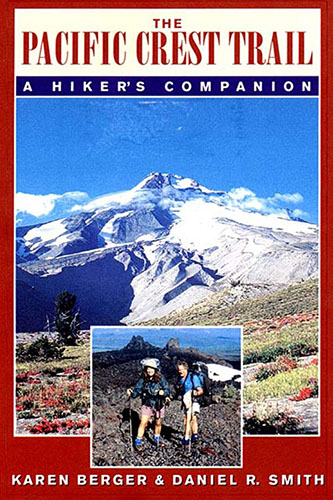HIGHLIGHTS: The Pacific Crest Trail is a officially 2650 miles but that will change in the next few years as it is rerouted to its original route through the Tejon Ranch in Southern California. The trail’s northern terminus is at Monument 78 at the U.S.- Canadian border. However, most thru-hikers finish their hike 7.2 miles north at Manning Provincial Park in British Columbia. The southern terminus is at the U.S.- Mexican border about 1.3 trail miles south of Campo, California – the site of a U.S. Border Patrol station. Unlike the Appalachian Trail, the Pacific Crest Trail is more than a footpath. It is open for equestrian as well as pedestrian use, but not mechanized use, i.e. mountain bikes. The Pacific Crest Trail (or PCT as it is often called) crosses 3 states, 24 national forests, 7 national parks and 33 wildernesses traversing the ranges of the Laguna Mountains, the San Felipe Hills, the San Jacinto and San Bernardino Mountains of the Desert Divide, the San Gabriel Mountains, the Sierra Pelona, the Tehachapi Mountains, the Sierra Nevada, the Southern Cascades, the Klamath Mountains, the Siskiyou Mountains, and the Cascade Range. It was officially dedicated on National Trails Day, June 5 1993, a lengthy 25 years after Congress passed the National Trails System Act in 1968. It is now federally protected under the administrative jurisdiction of the USDA Forest Service, but is primarily maintained and managed by the Pacific Crest Trail Association. The PCTA was first incorporated as the Pacific Crest Trail Conference in 1977 under the leadership of Warren Rogers and M. Merritt Podley. The Association hired its first paid staff in 1993 with help from a United States Forest Service grant. The same year the PCTA joined the U.S. Forest Service and other land management agencies in celebrating the completion of the trail with a “Golden Spike” ceremony near Soledad Canyon in the Angeles National Forest. While the trail is 100% built, nearly 300 miles are still on private property easements of from 8 to 20 feet in width. The PCTA and USDA Forest Service are working on acquiring private parcels from willing sellers, and widening the trail corridor to 500 feet either side of the trail. A thru-hike (or walking the entire length of the Pacific Crest Trail in a single year) is a major undertaking. Only about 200-300 hikers make the attempt annually, and fewer than 20-30 finish it the same year. Most thru-hikers start in early May from the southern terminus. The Sierra-Nevada snowpack is light in some years, making start dates in April possible. Regardless, most PCT guidebooks suggest that you finish the low areas south of the Sierra Nevada no later than mid-June. These miles are the hottest on the PCT, and it’s best to finish them before summer takes hold. Snow and thunderstorms occur in the Sierra-Nevada throughout the summer. Be aware that you can be brought to a halt by adverse weather conditions almost year-round. Typically, thru-hikers arrive in Oregon by August, and finish the PCT in British Columbia in September.
MORE DETAILS
|



Speak Your Mind